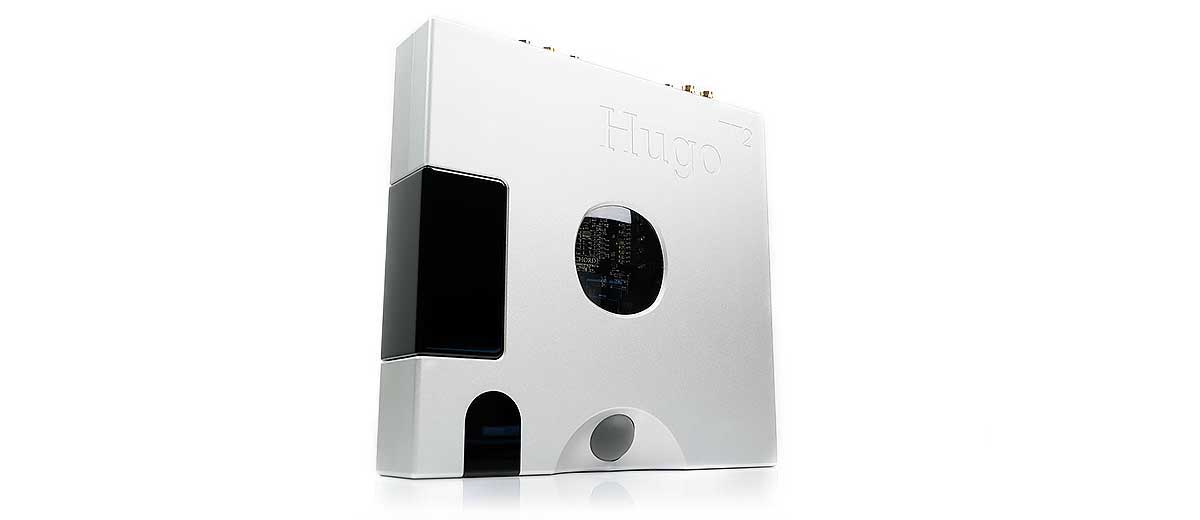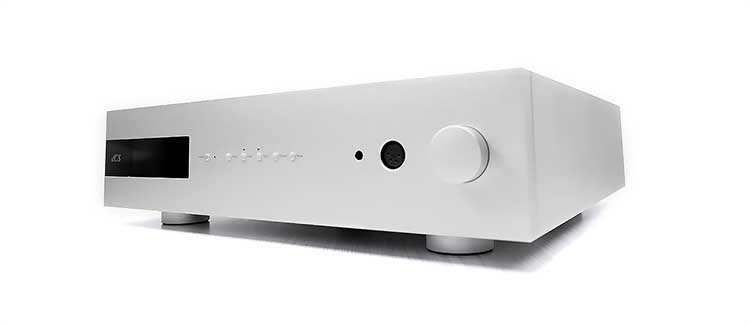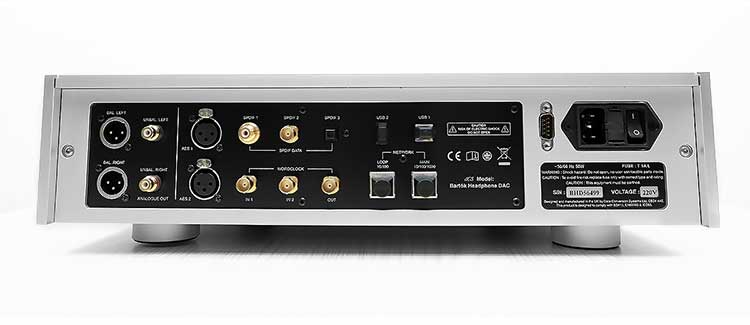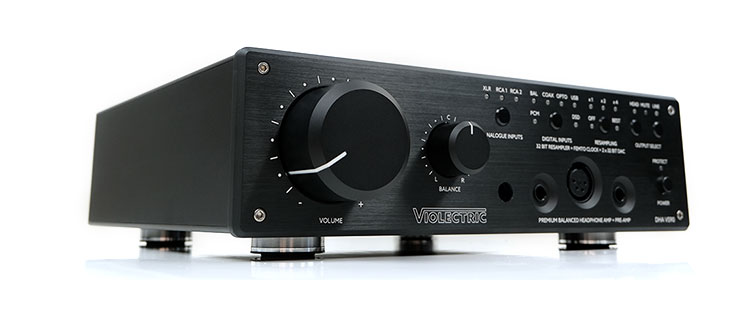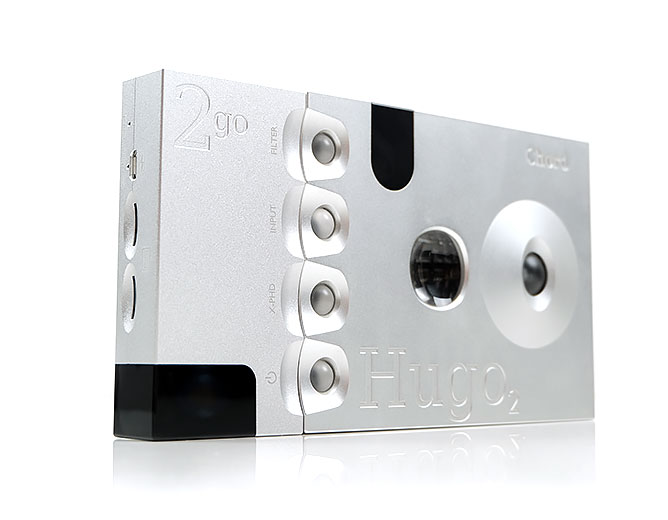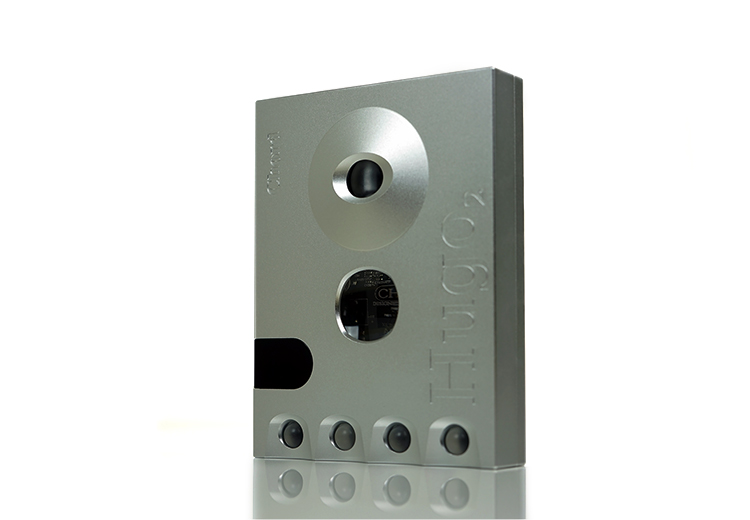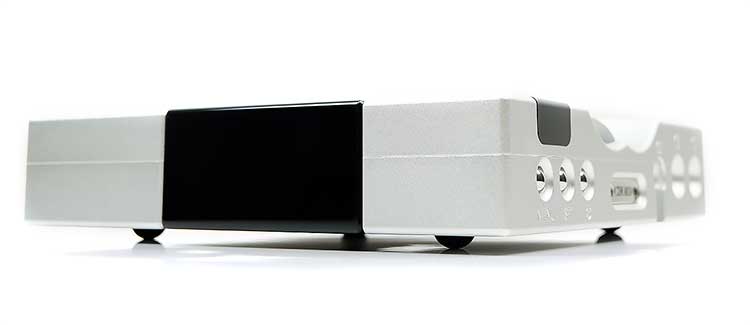Select Comparisons
dCS Bartok
$17250
The TT2 combined with the M Scaler is the closest I have to the Bartok, at least budget-wise but also in terms of ‘doing their own thing’. The TT2 is similar in terms of being a bespoke DAC and an integrated preamp and headphone amplifier.
It is also pitched to the high-end and, and like the Bartok, it can be expanded within a wider audio Chord audio eco-system. Modules such as the Hugo M Scaler and the TToby neatly stack above and below with connections aplenty for both headphones and traditional HiFi use.
WTA
Both stars of the show are the built-in DACs, which are not delta-sigma though very different from each other in their approach. The Hugo TT2 focuses on the tap limitation of delta-sigma blocks and hugely expands with their in-house FPGA-focused engineering to expand those ‘100s’ tap marker into nearly 100k taps using a Xilinx Artix 7 FPGA processor.
The processor allows for a much more complex level of filtering with no less than 86x 208MHz cores running in parallel. This allows the TT2 DAC to deliver an advanced 16FS WTA 1 filter with a ceiling of 98,304 taps.
Ring DAC
The Ring DAC is a discrete DAC that combines the proprietary FPGA control board with a DAC board using linking upgradeable software. The main purpose of the control board is to reduce noise, properly noise shapes the stream, and ensures the clocking is ultra-precise, i.e. do away with digital jitter before moving it to the digital audio conversion board.
The DAC uses dCS’s own proprietary mapping algorithm to take the sampled audio from the control side or decorrelates it from the signal thereby rendering mute any parts performance shift that can come from resistor-based topologies. In theory, the Ring DAC performance will not shift or denigrate over time as some ladder DACs can do.
Decoding
The Hugo TT2 does have an edge here in pure numbers with a decoding ceiling of DSD512 and PCM 32BIT/768kHz compared to DSD128 and PCM 24BIT/384kHz on the Ring DAC. Of course, how relevant that is depends on what you have on file and the Bartok is firmware upgradeable for decoding so that may not be fixed in stone for dCS.
The Bartok does have built-in upsampling capability via dCS Mosaic whereas the TT2 can be stacked with the M Scaler for a much more comprehensive upsampling capability. Unfair says you? A separate device yes but combined both are still around $5k less than the Bartok so there is that to think about.
Amplification
Both have competitive amplification outputs though, once again, different approaches. The Bartok primarily operates in the Class A domain though pushes into a Class AB operation sub 150mW with both unbalanced and balanced topologies.
Chord does not a huge amount about the topology of their amp design but we do know that is also a preamp and headphone amplifier with balanced outputs for pre-amping but unbalanced only for headphone output. We also know it also uses a discreet output stage between the DAC and filter and before the amplifier to reduce potential distortion.
The TT2 offers a wider range of unbalanced outputs at 3.5mm and two 6.35mm sockets compared to the balanced 4-pin XLR and a single 6.35mm unbalanced output of the Bartok.
The TT2 offers a flexible voltage supply of 288 mW RMS into a 300Ω load right up to 2.7W into 32Ω on the high-end unbalanced. The Bartok has a similar peaking rating of 2.7W but eases off on the voltage for lighter loads at 1.4W into 32Ω opting instead to maximize current demand. That 2.7W comes into play at a higher 66Ω level and levels out at a more powerful 600mW into 300Ω balanced.
Setup
For this comparison, I wanted to test a high-end current-intensive modern headphone, the Hedd Audio HEDDphones. At 87dB SPL and just 48Ω, it certainly fits the bill.
For the TT2 I also hooked up the M Scaler for some upsampling comparisons as I consider it vastly superior to the stock TT2 sound. Considering both Chord units together are still a bit cheaper than the Bartok this is fair game.
Performance
With the HEDDphone what you want to hear is that signature subterranean bass it is capable of. Both units perform do brilliantly in terms of pulling out an excellent low-end extension from this pairing.
However, the stock TT2 sounds more neutral to my ear in terms of quantity and forwardness. Not that the Bartok is a bass machine it just so happens the HEDDphone forte is incredible bass and that is where you hear a big difference between these two.
The Bartok sounds richer, slightly warmer, and more natural-sounding in its bass timbre, and well, to be honest, that liquid tone extends throughout the curve. More than that the dynamic range on the Bartok is that bit more convincing. Spatial cues leap out at you, the staging is more complex yet at the same time, it holds onto that wonderfully natural tone not once sounding artificial in its delivery.
The TT2 on the other hand is the cleaner, lighter in delivery, with a ‘faster sound’ and a very precise placement. It is a ‘detail master’ in that regard.
You could make an argument that the TT2 is the more linear of the two in terms of how it sounds with the HEDDphone offering a neutral to slightly warm tone throughout the mids and into the treble. It is prim and proper with nothing out of place.
M Scaler Added
Now throw in the M Scaler and the gap tightens up. The M Scaler makes the stock TT2 sound rather muted and flat by comparison. The upsampling delivers a much more vivid performance particularly with vocals that come further forward in presence, close to how the Bartok positions them.
Certainly, in terms of dynamic range and engagement, it is much closer to the Bartok. However, the overall tone doesn’t change and that may be to the Bartok’s advantage. The TT2 is still a cleaner, pacier tone and a little lighter in body compared to the Bartok with the Heddphones.
The Bartok still has more ‘character’ in its timbre, and by that, I mean nuanced detail such as vocal breathing techniques, lisps, or short intakes. All have a bit more definition on the Bartok like you are standing in front of a live performance.
The TT2/M Scaler combo seems to erase some of those vocal ‘quirks’ in favor of that perfect studio delivery. It might seem a little less analog in tone but it compensates with just throwing out a wall of crazy detail.
Violectric V590
$3499.95
DAC & Sampling
Like the V590 the Hugo TT2 is also a DAC, preamp, and headphone amplifier but there a number of big differences internally and externally between these two similar priced systems. The Chord uses a proprietary DAC based on WTA or tap length design by Rob Watts.
Instead of a delta-sigma solution, the TT2 uses a custom-coded Xilinx Artix 7 FPGA with 86x 208MHz cores running in parallel to create an advanced 16FS WTA 1 filter with 98,304-taps. Typically pitched as outpacing delta-sigma taps that number in the hundred.
You could argue that the dual-AK4490EQ inside the V590 is no match for this on paper and in terms of decoding future-proofing, it isn’t with up to PCM 32BIT/768kHz decoding and DSD512 native decoding from the TT2 compared to native DSD256 and PCM 32BIT/384kHz for the V590.
Of course, that is not the final word because both have integrated amplification stages that do indeed color the sound differently. The V590 also has built-in resampling for which the TT2 required the Hugo M Scaler combined to be able to offer resampling. Admittedly, the M Scaler resampling is excellent but the Chord combo comes at double the cost of the V590 alone.
A few other important differences surround the level of integration. The V590 is far more flexible with the ability to use just the headphone amp and connect to a 3rd party DAC via analog inputs.
The Hugo TT2, like the V590, will allow you to DAC out to an amp of your choice as a preamp but not DAC-in to use the TT2 headphone alone. Instead, the TT2 modular scaling is on the digital side such as the use of dual BNC for M Scaler functionality.
Amplification
Both have excellent amplification outputs though, once again, different approaches. The V590 primarily operates in the Class A domain though pushes into a Class AB operation sub 50mA with both unbalanced and balanced topologies. It also offers a pre-amp output and a fixed lineout with a manual switch at the back able to control both.
The TT is also a preamp and headphone amplifier with balanced outputs for pre-amping but unbalanced only for headphone output. We also know it also uses a discreet output stage between the DAC and filter and before the amplifier to reduce potential distortion.
The TT2 offers a wider range of unbalanced outputs at 3.5mm and two 6.35mm sockets whereas the V590 offers both balanced and unbalanced with 4-pin XLR and two 6.35mm sockets.
The TT2 offers a flexible voltage supply of 288mW RMS into a 300Ω load right up to 2.7W into 32Ω on the high-end unbalanced. The V590 can deliver 740mW into a 600Ω load and peaks at 5.5W at 50Ω before dropping to a 4W at 32Ω.
Noise
There isn’t a huge amount of correlative data to directly compare noise levels between the two system outputs but on paper, the dynamic range of these two systems outputs are excellent with the V590 rated at 132dB and the TT2 at 127dB, both A-weighted. Bear in mind though this is optimal and not like for like as the TT2 is single-ended only whereas the V590 rating is balanced.
The TT2’s provision of a 3.5mm output jack is a hint though as this is a much quieter amp for sensitive IEMs like the Solaris. Not that the V590 is noisy but it does have a higher noise floor with Campfire Audio’s hiss detector Solaris. Both run nice and quiet with 64 Audio’s 104dB SPL tia Trio and the V590 closes the gap a little once you throw on the -18dB pre-gain switch.
Performance
Some definite differences between these two particularly in timbre and imaging. From a staging perspective, the TT2 is more forward and immediate through the mids whereas the V590 pushes back a little bit and sounds a bit more relaxed in its delivery.
It is like the difference between a studio and a live recording in a manner of speaking. The TT2 presentation on the Heddphones is vivid, vocals are to the fore, timbre is accurate, the pace is fast, and the articulation is crazy good. The perfect studio performance you could say.
The V590 pulls you back from the front row a little more, offering a bit more warmth in the process across the FR but also a slightly larger staging quality. I suspect there is a bit more weight on the low-end that acts as a factor in this perception because our test Heddphones can go incredibly deep on a good amplifier.
Instrumental timbre is a shade softer, more euphonic with a note decay that perhaps lingers a bit longer on the V590. Vocals have a more liquid tone but in terms of imaging, they sit further back as does the treble presence compared to the TT2.
It may well be that more neutral vocal positioning contributes to the perceived additional space or ambiance because of the way the TT2 pushes right up to you with its vivid and detailed presentation.
Chord Electronics Hugo 2
£1800 (£995 additional for the 2Go)
The Hugo 2 is cheaper than the TT2, even with the 2Go wireless module added. Given its predominantly portable classification and compact design, the price gap is not surprising.
And yet still, there is some commonality between these two devices that are worth comparing for Hugo 2 users thinking of upgrading or those TT2 owners who are wondering the Hugo 2 will give them the same sound quality ‘on the go’.
Digital
Both house the same internal DAC design using the Xilinx Artix 7 FPGA processor. However, the level of filtering on the TT2 is much higher with those 86x 208MHz cores running in parallel. The TT2’s advanced 16FS WTA 1 filter can offer up to 98,304 taps compared to the Hugo 2’s 49,152 tap ceiling.
In terms of decoding, however, both can actually offer similar levels of performance with the two systems able to offer 768kHz/32-bit PCM with a native DSD playback capability of up to DSD512. Both devices offer Chord’s excellent digital filter system and crossfeed, (X-PHD) but the Hugo 2 is missing a high/low gain option which the TT2 does offer in amp mode.
Both devices offer wireless connectivity out of the box with BT4.2 and up to aptX decoding capability which is a bit dated now for me. However, with the addition of the 2GO module for the Hugo 2, you can now add ethernet and WiFi streaming capability as well as app control for lossless audio playback.
DSD will drop to DSD256 over DoP however when using the 2Go with the Hugo 2 wirelessly but that is one feature the Hugo TT2 has yet to offer. Roon Ready Hi-Res streaming via a Smartphone Roon End Point was seamless and very easy to use via 2Go.
Analog
In terms of amplification, both use Class A designs, however, the TT2 is able to offer a lot more in terms of headphone output power as well as its stronger pre-amping capability.
On the headphone side, the TT2 offers a flexible voltage supply of 288mW RMS into a 300Ω load right up to 2.7W into 32Ω on the high-end unbalanced. The Hugo 2 drops down to 740mW equivalent into a 32Ω load which puts on the fence for more demanding planar headphones that the TT2 has no issues with such as Hifiman’s Susvara or the Abyss Headphones Diana Phi.
On the pre-amping side, the TT2 can offer both balanced and SE outputs to feed into pure amps or power amps at up to 7.3W into 8Ω SE and 18W balanced on the same load. The Hugo 2 only offers SE via a dual RCA output in pre-amp mode and it has a maximum of 1050mW into an 8Ω load.
Design
Obviously, a more compact portable device, the Hugo 2 is dwarfed by the size of the TT2 which is very much a desktop component. Still, some, including myself, have used the Hugo 2 as a system DAC or a desktop DAC/Amp and it is designed for that as well as OTG portability.
There are pros and cons to that approach compared to the TT2. For a start, the TT2 size allows it to pack in a lot more functionality such as an additional 6.35mm SE headphone output, dual BNC for Hugo M Scaler compatibility, as well as two optical inputs compared to just 1 on the Hugo 2. Add the 2Go it becomes a little longer but with additional microSD storage capability.
The TT2 also has a dedicated balanced line out for pre-amp duties suited for power amps such as the Chord’s own TToby which makes it a more suitable component for HiFi systems compared to the SE only output on the rear of the Hugo 2.
Though both have handy and quite similar remote controls, the ability to tweak the setup on the TT2 is much easier than the Hugo 2 with that LCD panel compared to just pure orb color coding.
The one final difference is power, internal power. The Hugo 2 does have separate data and charging ports but these are micro-USB which are a bit dated now.
Battery life on the Hugo 2 is not great at around 7 hours so you may find yourself having to charge more than once a day for continued use. The 2Go is slightly better at around 8 hours. The TT2’s six supercapacitors are all DC-powered with a DC15v input and 4 amp switch mode power supply (SMPS).
Performance
For this comparison, we detached the M Scaler which would give the TT2 a big lift in terms of superior performance. Allowing stock versus stock gives us a better understanding of how both compare to each other.
The first thing I did notice was the superior dynamic range, particularly with demanding headphones such as the HEDD Audio HEDDphones which sounded more optimal with the better output power of the TT2.
On both the detail is excellent but the way it is presented in terms of impact combined with the black background is more convincing on the TT2. The Hugo 2, by comparison, felt a little bit smaller in terms of staging and not quite as holographic sounding.
Both can spread the sound out quite wide but the additional depth of the TT2 and keener imaging creates a more complex and immersive presentation. You can quickly pick up on the superior instrumental and vocal separation from the TT2 over the Hugo 2.
In terms of timbre, the Hugo 2 is marginally the drier of the two units with a little more harmonic dissonance over the vocal and upper mids. This creates a stronger perception of sibilance in Hugo 2 vocals and more contrast in percussion hits.
The harmonic balance on the TT2 is sweeter and smoother through the mids and treble with more body and warmth coming in from the low-end. The vocal character sounds more life-like offering better detail in instrumental and vocal texture.
Our Verdict
The Chord Electronics Hugo TT2 is an absolute powerhouse of a combo with a highly detailed DAC and a smooth-sounding amplification stage that can handle a very wide range of headphones.
Its calling card is timing, precision, and bags of detail but rather than a dull neutral delivery it is perhaps surprisingly more musical in its approach than either the Hugo 2 or the Qutest DAC.
Its modular capability is the X-Factor here and without a shadow of a doubt adding the Hugo M Scaler and a proper set of BNC cables lifts the performance to world-class. This is a lovely compliment to the earthy and rich natural tones of the dCS Bartok and I admit it comes damn close for less money with the M Scaler stacked on top.
My caveats? Two standouts with the first being a dated BT aptX maximum decoding module which seems at odds with the high-end performance of the wire section. I would have loved to have seen a proper LDAC transmit and receive module inside for better dynamic range performance. Much cheaper DAC’s now offer this and so should Chord.
The second might be the lack of balanced 4-pin XLR or 4.4mm PO outputs. Many audiophiles might be looking for that considering the preamp has a balanced output option on the rear.
Apart from that, the Hugo TT2 is still a long-game DAC and amp combo in 2021. There is not much the TT2 cannot do aside from the lack of wireless options. Quite apart from its marvelous sound it is future-proofed to the hilt for just about every lossless codec currently out there in the market.
Chord Electronics Hugo TT2 Specifications
- Tap length filter: 98,304-tap 16FS WTA 1 – 10 element design
- Connectivity (input): 1x USB Type-B, 2x Coax BNC, 2x Optical & Bluetooth
- Connectivity (output): Stereo XLR, Stereo RCA, 2x 6.5mm Headphone jack & 1x 3.5mm Headphone jack
- Connectivity (digital output): 2x DX BNC (expansion outputs)
- Weight: 2.53kg
- PCM support: 44.1kHz, 48kHz, 88.2kHz, 96kHz, 176.4kHz, 192kHz, 358.8kHz, 384kHz, 705.6 and 768kHz – 16 to 32bit
- DSD support: DoP DSD 64 to DSD 512 – native via Windows
- Volume control: Digital
- Line-level mode: Activated within the menu
- Driver support: Driverless with Mac OS X and Linux, driver required for Windows OS
- Dynamic range: 127dB ‘A’ weighted
- Noise: 4 uV ‘A’ weighted (high gain), 1.7 uV ‘A’ weighted (low gain) with no measurable noise floor modulation
- Distortion: 0.00008% @ 2.5 V 300Ω; 0.00016% @ 6 W 8Ω
- Output power (unbalanced): (@1% THD) 288 mW RMS 300Ω; 7.3 W RMS 8Ω
- Output power (balanced): (@1% THD) 1.15 W RMS 300Ω; 18W RMS 8Ω
- Output impedance: 0.042Ω
- Stereo separation: 9 V RMS 300Ω -138dB
- Dimensions: 5.2cm (H) 23.5cm (W) 23.8cm (D)

